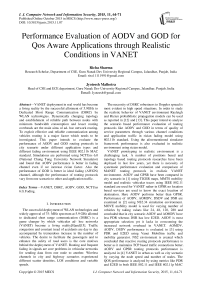Performance Evaluation of AODV and GOD for Qos Aware Applications through Realistic Conditions in VANET
Автор: Richa Sharma, Jyoteesh Malhotra
Журнал: International Journal of Computer Network and Information Security(IJCNIS) @ijcnis
Статья в выпуске: 11 vol.7, 2015 года.
Бесплатный доступ
VANET deployment in real world has become a living reality by the successful allotment of 5.9GHz to Dedicated Short Range Communication (DSRC) by WLAN technologies. Dynamically changing topology and establishment of reliable path between nodes with minimum bandwidth consumption and lesser routing overheads are the main aims of ad- hoc network routing. To exploit effective and reliable communication among vehicles routing is a major factor which needs to be investigated. This paper intends to evaluate the performance of AODV and GOD routing protocols in city scenario under different application types and different fading environment using IEEE 802.11b MAC standard. Simulations are performed using NCTUns 6.0 (National Chung Tung University Network Simulator) and found that AODV performance is better in fading channel even if we increase rician factor. Also the performance of GOD is better in ideal fading (AWGN) channel, although the performance of routing protocols vary from one scenario to other and application traffic.
VANET, DSRC, AODV, GOD, NCTUns 6.0, Fading
Короткий адрес: https://sciup.org/15011474
IDR: 15011474
Текст научной статьи Performance Evaluation of AODV and GOD for Qos Aware Applications through Realistic Conditions in VANET
Published Online October 2015 in MECS DOI: 10.5815/ijcnis.2015.11.07
The successful deployment of WLAN technologies and widely approval of 75- MHz spectrum at 5.9 GHz allotted to dedicated short range communication (DSRC) is a game changer by which vehicular ad- hoc networks (VANET) become a living reality[8]and[15]. Traffic congestion and constant tread of accidents are day to day accompanied by tremendous increase in the number of vehicles. The desire to facilitate the passengers and to enhance the safety of road users is the core motives behind the deployment of VANET. Routing and frequent fading in signals are core problems in vehicular networks for sending data from one node to another. Wireless channels in city and highway scenarios experienced different scatter densities, LOS conditions and variable speeds.
The necessity of DSRC robustness to Doppler spread is most evident in high speed situations. In order to study the realistic behavior of VANET environment Rayleigh and Rician probabilistic propagation models can be used as reported in [12] and [13]. This paper intend to analyze the scenario based performance evaluation of routing protocols like AODV and GOD in terms of quality of service parameters through various channel conditions and application traffic in rician fading model using 802.11b standard. Using the aforementioned simulator framework performance is also evaluated in realistic environment using rician model.
VANET prototyping in realistic environment is a challenging task. A number of positions based and topology based routing protocols researches have been deployed in last few years, yet there is necessity of systematic performance evaluation and comparison of MANET routing protocols in realistic VANET environment. AODV and GPSR have been compared in city scenario in [1] using TIGER maps, MMTS mobility model and realistic vehicular traces using IEEE 802.11 standard are used for VANET rather in GPSR no location based services are used to know the exact location of destination. Here AODV performs better than GPSR. Performance of AODV, AOMDV, DSDV and DSR are examined in [2] using NS2.34 simulation environment. MOVE mobility model is used for varying number of vehicles by taking values like 24, 48, 120, 280 and concluded that in city scenario AODV and AOMDV have less PDR whereas DSR has low E2ED. AODV is most appropriate selection yet it lacks in overcoming the increased network overhead in VANET. AOMDV, AODV, DSDV performance is evaluated in [3] using PDR and E2ED using Vanet MobiSim traffic and mobility generator. NS2 environment is created which concluded that reactive routing protocols performance is better as it maintains TCP based traffic connections better. AODV and GPSR routing protocols performance is analyzed in [4] VANET in urban as well as city scenario by varying the node speed and number of nodes. The QOS performance is analyzed by using metrics like PDR and E2ED in both IEEE 802.11 and IEEE 802.11p MAC standards and concluded that AODV performs better than GPSR. Furthermore from the above related work it is concluded that no such research paper have considered a realistic scenario having both network and traffic capabilities together. So the study presented in [7] is extended to city based scenario and performance is evaluated of AODV and GOD with different application traffic and realistic fading models like AWGN and Rician using IEEE 802.11 MAC/PHY standard.
The rest of the paper is structured as follows: In section II throws light on the background related to routing protocols, channel condition and application traffic used in fading environment. Section III presents brief overview of the simulation methodology used. Section IV shows the results obtained in with fading environment and ideal environment under simulative investigation. At last section V concludes the paper.
-
II. Background
-
A. Routing Protocols
Routing protocols plays a significant role in managing communication between vehicles which are out of the radio range of each other. So, the evaluation of performance of VANET relies on these routing protocols. Nevertheless, the results of the collaboration of MANET and VANET showed that the performance is not that much over welcoming due to high mobility, varying speed, rapid topology changes, frequent fragmentation and high dynamic network density [13]. In literature three classes of routing protocols are listed namely reactive, proactive and geographical routing protocols [11]. Yet these approaches have their pros and cons and no single routing protocol is able to perform efficiently in all realistic scenarios. Following are some of the protocols to be chosen among all protocols suiting for simulative investigation in different traffic scenarios:
-
• AODV: Ad- Hoc on Demand Distance Vector routing protocol belongs to pure reactive routing protocol family in which it starts route discovery when a node wants to communicate with another node and route assurance is done on demand criteria. It reduces route redundancy, requirement of large memory and unnecessary flooding of RREQ. AODV in VANET is used to regulate the mobile traffic as it uses TTL field in the IP header to limit the search.
-
• GOD: General Operation Directory algorithm in ad-hoc networks stores global information relevant to state of nodes, network and environment. Movement patterns are managed by GOD during simulations.
-
B. Application Traffic
Application traffic helps to capture delay, jitter and packet drop. Log files are storage space for all the traffic statistics of mesh nodes and mesh routers wireless interface card. In traffic generation and data collection processes various application traffic are used like stg, rtg, stcp, stcp, rtcp. ttcp, rtpsendrecv and rtprecvonly. Stg (Send traffic grapher) and Rtg (Receiver traffic grapher) tools are used to send and receive traffic in both TCP/UDP nodes. Stg and Rtg are used to simulate the VoIP traffic which uses RTP and UDP. They have constant bit rate in various packet streams. If the internet host wants to set up greedy UDP/TCP traffic, the command “stg 400 1400 1.0.1.2(IP address) –p (port number)” must be specified in the sender host, while the command “rtg –u (UDP) –wlog1 –p (port number) 2007” must be specified in the receiver. Stcp (Send transmission control protocol) and Rtcp (Receiver transmission control protocol) are used to generate greedy TCP traffic. They support real time conferencing of groups like traffic source identification, multicast to unicast translators and many more. Later in simulative investigation stg and rtg application traffic are categorized in T1 traffic and stcp and rtcp are categorized in T2 application traffic.
-
C. Fading
Fading means rapid fluctuations of the phases, amplitudes and multipath delays of a radio signal for either short duration or short travel distance. Speed of vehicles, multipath propagation, speed of surrounding objects, transmission bandwidth of the signal are the various factors influencing fading in the radio propagation channel. In NCTUns6.0 three different fading models are described: No fading (AWGN noise), Rayleigh fading and Rician fading. [12] AWGN fading is a kind of noise which affects the transmitted signal when it passes by the channel. It consists of uniform continuous frequency spectrum over a particular frequency band. In Rayleigh fading no LOS path relies between transmitter and receiver as they have only indirect path. The resultant signal consists of sum of all the reflected and scattered waves. In Rayleigh the relative strength parameter has K=0 value which means no LOS and on the other hand K=infinity means no effect of fading and nodes within range can easily communicate. In rician fading there is both LOS and non-LOS paths between the transmitter and receiver i.e the resultant signal have both direct and scattered multipath waves. Later in this paper AWGN (no fading) environment and Rician environment having K=4 and K=8 realistic fading environment has been created to validate our findings.
-
III. Simulation Methodology
For real traffic systems in VANET simulation platform could be used as an emerging counterpart that helps to create any network, analyze and solve real traffic related problems. Although test beds are expensive as testing of network protocols and algorithms on real platform needs lot of connection among routers, data links and lot of money. The simulation models of VANET need to be diverse. They must be able to correctly model the behavior of the driver, movement pattern of vehicles, robustness in high obstacle environment and correct modeling of radio channel. In the past research community have used various simulation tools for evaluating the performance of VANET. [9] Amongst NCTUns6.0 is most popular and most citied simulator for VANET environment used here. This section starts with providing a realistic framework by listing various simulation parameters that are used in simulation. Afterwards the simulation scenario is framed.
-
A. Performance Parameters
The following QOS parameters are used in this paper to evaluate the performance of both AODV and GOD routing protocol in highly mobile realistic environment in VANET
-
• Packet drop ratio: Packet drop defines the total number of packets not successfully reach to receiver. Fading, congestion, traffic and queue overload can be reasons behind major packet drop and lesser the packet drop higher is protocol performance.
-
• Collision rate: The numbers of packets collide per second defines the collision rate. Lesser the collision rate higher is packet delivery ratio and better is the performance.
-
• Throughput of incoming packets: It defines the average number of successful delivered incoming packets on a particular network node.
Throughput (KB/sec) = Σ (Number of incoming packets at destination) * Packet size
Σ Simulation Time
-
• Throughput of outgoing packets: It defines the average number of successful delivered outgoing packets on a particular network node.
Throughput (KB/sec) = Σ (Number of outgoing packets at destination) * Packet size
Σ Simulation Time
-
• Broadcast rate of incoming and outgoing packets: This parameter defines the rate of incoming and outgoing packets to be broadcasted on a particular network channel.
-
B. Simulation scenario
A city scenario is created here with variable traffic tools and different channel conditions in realistic environment. Two Way Ground propagation model is used here for perfect signal strength which ignores the effect of obstacles present in the environment. The scenario is drawn with help of “draw topology” feature of simulator NCTUns6.0. Then using the “edit topology” feature various performance parameters are deployed according to the channel requirement as shown in table listed below in table 1.
While considering the performance parameters simulations are performed by using “run” interface available in the toolbar kit of the NCTUns 6.0 workplace and simulation scenario is created.
Table 1. Simulation Parameters
|
Parameters |
Values |
|
NCTUns Version |
6.0 |
|
Channel Type |
Wireless LAN (ad-hoc) |
|
Path Loss Model |
Two Ray Ground |
|
Fading Model |
AWGN, Rician |
|
Rician Factor (K) |
4DB, 8DB |
|
Traffic Tool |
Stg, rtg, stcp, rtcp |
|
MAC Protocol |
802.11b |
|
Routing Protocol |
AODV, GOD |
|
Mobility Model |
Manhatten Grid |
|
Antenna Gain (dpi) |
1 dpi |
|
Transmission power |
15dpm |
|
Frequency (MHz) |
2400 |
|
Number of nodes |
16 |
|
Speed |
100 kmph |
|
Simulation Time |
80s |
|
Street Width(m) |
30.0 |

Fig.1. City Scenario Case with 16 Nodes.
-
IV. Results and Discussion
This section explains the results obtained by using AODV and GOD routing protocols in city scenario. Subsection A shows effect of changing the traffic type in AWGN (No Fading) environment while subsection B shows effect of changing application traffic in Rician Fading realistic environment.
-
C. Effect of changing application traffic in AWGN channel
The performance of AODV and GOD has been examined in city scenario in no fading environment by taking 16 numbers of nodes while keeping speed 100kmph.
Fig 2 shows PDR ratio of Stg/rtg (T1) and Stcp/rtcp (T2) type of traffic for AODV and GOD in ideal environment. It has been examined that for traffic type T2 the packet drops are more for AODV and lesser for GOD. On the other hand for T1 traffic tool the GOD has greater packet drop ratio as compared to AODV. The lower the packet drop ratio greater will be the throughput, as because of the routing overheads the packets are dropping. Fig 3 shows collision rate for AWGN channel. Higher the collision rate the greater the packets will drop and lesser will the throughput. In case of AODV for T2 traffic type it has average value of 20% for collision rate which is high as compared to GOD. Fig 4 and Fig 5 shows that the throughput rate of incoming and outgoing packets is high in AODV for traffic type T2 as average value is 5.014% much greater than GOD. Fig 6 shows that broadcast rate of incoming and outgoing packets is greater for both application traffic for AODV routing protocol. It is concluded that AODV has larger routing overheads as it requires greater broadcast rate of incoming and outgoing packets for both application traffic. Later table 2 describes clearly the exact value of various QoS parameters.
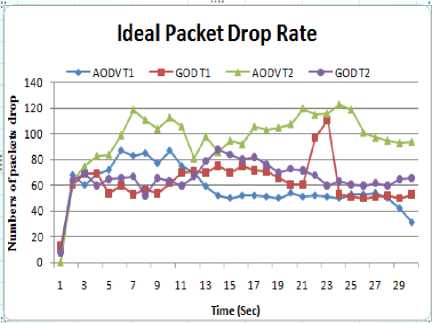
Fig.2. PDR Ratio of AODV and GOD in AWGN for Both Application Traffics
Ideal Collision Rate
-♦-AODVn -e-GODn -*-AODVT2 -*-GODT2
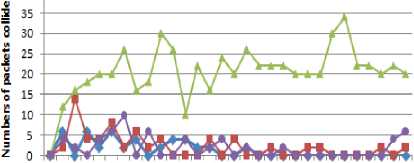
12 3 4 5 6 7 8 9 101112131415161718192021222324252627282930
Time (Sec)
Fig.3. Collision Rate for AODV and GOD in for AWGN Both Application Traffics.
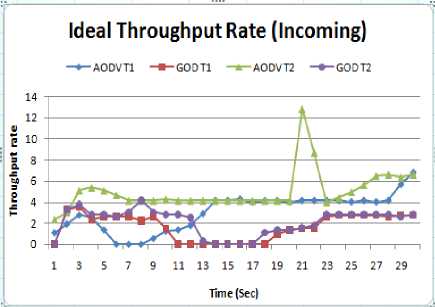
Fig.4. Throughput Rate of Incoming Packets for AODV and GOD in AWGN for Both Application Traffics
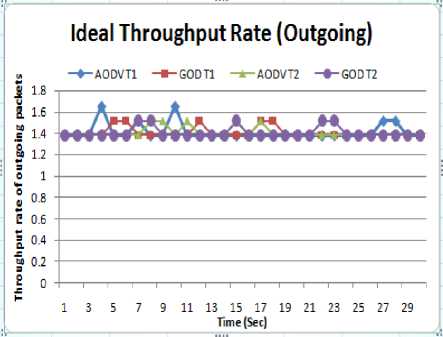
Fig.5. Throughput Rate Outgoing Packets for AODV and GOD in AWGN for Both Application Traffics
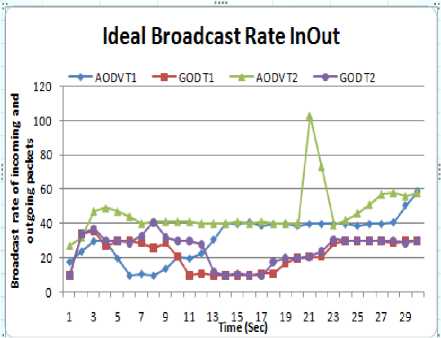
Fig.6. Broadcast Rate of Incoming and Outgoing Packets for AODV and GOD in AWGN for Both Application Traffics
-
D. Effect of changing application traffic in rician channel
The performance of AODV and GOD is analyzed in realistic environment by taking 16 number of nodes and taking Rician factor 4 and 8 while keeping speed at 100 kmph.
-
• For Rician factor K=4
Fig 7 shows PDR ratio of T1 and T2 traffic type for AODV and GOD in rician environment. Packet drop ratio is greater for GOD in T1 traffic when realistic fading is introduced. The results shows that fading environment has reverse effect on packet drop ratio as here in GOD with channel change the chances of link failure increases which leads to packet loss. Fig 8 shows the collision rate which shows that GOD has high collision rate due to greater packet loss. The average value is 9.3% in GOD much higher than AODV. Fig 9 and 10 shows the throughput rate of incoming and outgoing packets is greater for GOD by 3.15% for K=4 channels even it lacks in collision rate and packet drop ratio. This may be concluded that GOD is preferable than AODV when we have low value of fading in realistic channel.
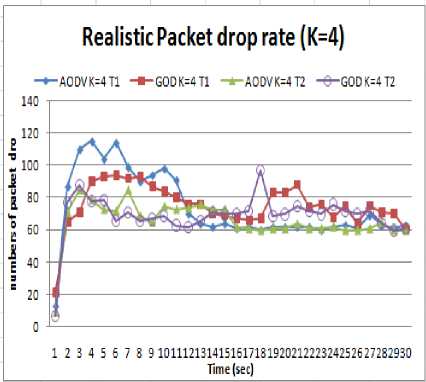
Fig.7. PDR Ratio of AODV and GOD in Rician K=4 Channel For Both Traffics.
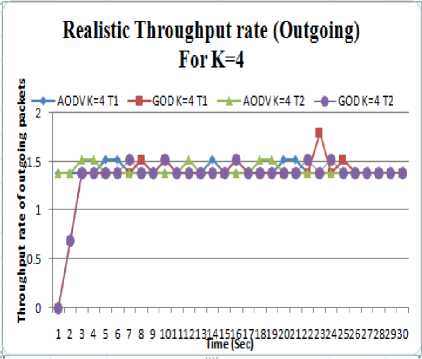
Fig.10. Throughput Rate of Outgoing Packets for AODV and GOD in Rician K=4 Channel for Both Application Traffics.

Fig.8. Collision Rate for AODV and GOD in Rician K=4 Channel For Both Traffic.
Realistic Broadcast Rate InOut (K=4)

Fig.11. Broadcast Rate of Incoming and Outgoing Packets for AODV and GOD in Rician K=4 Channel for Both Application Traffic.
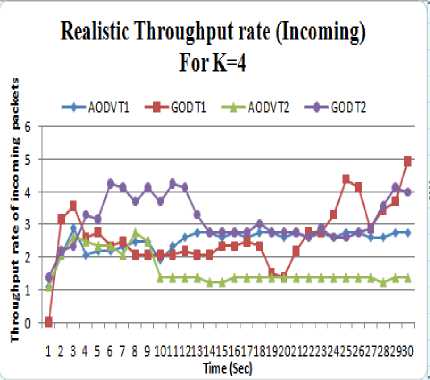
Fig.9. Throughput Rate of Incoming Packets for AODV and GOD in Rician K=4 Channel For Both Application Traffic.
-
• For Rician Factor K=8
In this section the performance is analyzed of AODV and
GOD in realistic channel by considerin 16 number of nodes and rician factor value 8 whicle keeping speed 100kmph.
Fig 12 shows that PDR ratio of GOD is greater by 84.96% AND 82.43% in T1 and T2 traffic type even by increasing the fading by 8. Fig 13 shows the collision rate of GOD is also greater by 5.06% and 4% of both T1 and T2 traffic type as compared to AODV. Although with introducing increase in fading channel AODV outperforms better by having good throughput rate of incoming and outgoing packets in 14 and 15. The broadcast rate of incoming and outgoing packets is greater in T1 traffic type of AODV. This may be concluded that AODV is better when fading is high as it has low packet drop, low collision rate in both application traffic. Later table 2 describes clearly the exact value of various QoS parameters.
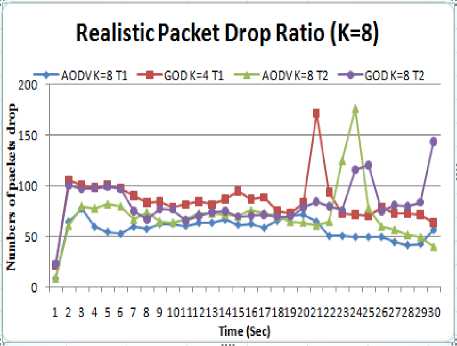
Fig.12. PDR Ratio of AODV and GOD in Rician K=8 Channel For Both Application Traffic.
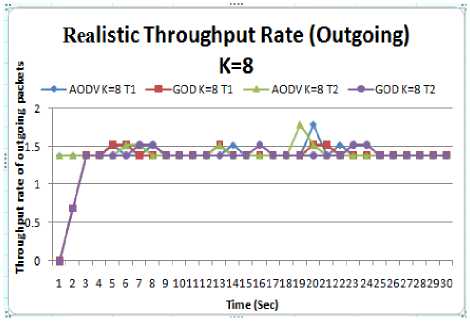
Fig.15. Throughput Rate of Outgoing Packets for AODV and GOD in Rician K=8 Channel for Both Application Traffic.
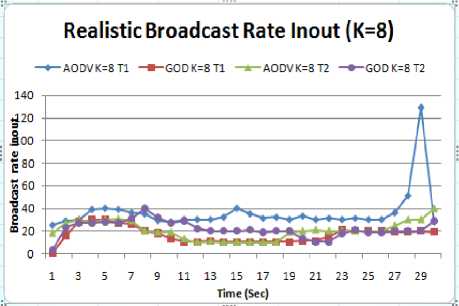
Fig.16. Broadcast Rate of Incoming and Outgoing Packets for AODV and GOD in Rician K=8 Channel for Both Application Traffic.
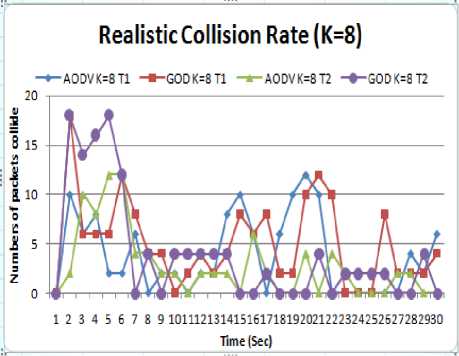
Fig.13. Collision Rate for AODV and GOD in Rician K=8 Channel For Both Application Traffic.
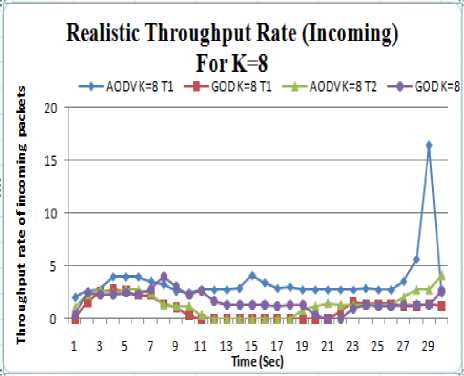
Fig.14. Throughput Rate of Incoming Packets for AODV and GOD in Rician K=8 Channel For Both Application Traffics.
V. Conclusions
This paper analyzed the performance of AODV and GOD routing protocols for VANET using IEEE 802.11b MAC standard under T1 and T2 traffic type in city scenario in realistic environment. In AWGN (no fading) channel for T2 traffic type AODV has grater packet drop ratio and collision rate as compared to GOD. Throughput rate of AODV outperforms high yet for T2 traffic type it suffers from high packet drop and collision rate. It is concluded that in no fading environment GOD is better yet its throughput is slight lesser than AODV but it yields in low packet drop ratio and collision rate in T2 type of traffic. Simulation results of AODV and GOD in rician channel taken from table 2 depicts that for Rician factor value 4 GOD lacks in PDR and Collision ratio yet its throughput is slight high if we take 16 number of nodes. Still we prefer AODV as it has less packet drop and throughput. Afterwards if we introduce fading by taking rician factor 8 it has been analyzed that AODV outperforms than GOD in terms of throughput and have low PDR and collision rate. In realistic channel AODV is much better which proves its robustness for scalability and mobility. VANET has attracted much attention from research community as it is a hot area of research. Many issues still need to be resolved. Later performance issues regarding time delay and path connectivity should be improved. Also in future the analysis work can also be scenarios. extended to versatile source-destination in realistic
Список литературы Performance Evaluation of AODV and GOD for Qos Aware Applications through Realistic Conditions in VANET
- B. Rama Krishan, R.S Rajesh and R.S. Shaji,"Analysis of Routing Protocols for Highway Model without using Roadside Unit and Cluster," International Journal of Scientific and Engineering Research, Vol 2, pp1-9, Jan 2011.
- Dharmendra Sutariya, Shrikant Pradhan "Evaluation of Routing Protocols for VANET in City scenario" Proceedings of the International Conference on Computer and Communication Engineering 2011 May 13-15, 2011 Kuala Lumpur, Page(s):267-272 IEEE publications.
- Shaikhul Islam Chowdhury, Won-Il Lee, Youn-Sang Choi, Guen-Young Kee, and Jae-Young Pyun "Performance Evaluation of Reactive Routing Protocols in VANET" 2011 17th Asia-Pacific Conference on Communications (APCC) IEEE 2nd – 5th October 2011.
- Raj Bala, C. Rama Krishna, "Scenario Based Performance Analysis of AODV and GPSR Routing Protocols in a VANET," IEEE International Conference on Computational Intelligence and Communication Technology, pp- 432-437, Feb 2015.
- C.A.T.H. Tee and A.C.R. Lee, "Survey of Position Based Routing for Inter Vehicle Communication System," in proceedings of 1st International Conference on distributed framework and application, Oct 2008 pp-172-182.
- Haerri J, Filali, F and Bonnet C. "Performance comparison of AODV and OLSR in VANET Urban Environment using realistic mobility patterns", Procedding of the 5th IFIP Mediterranean Ad-Hoc Networking Workshop, pp- 14-17, Lipari, Italy June 2010.
- Richa Sharma, Komal Sharma, Dr. Jyoteesh Malhotra, " Simulative Investigation Of Routing Protocols In Vanet In Realistic Environment" , accepted in IEEE international conference of Futuristic Trends in Computational Analysis and Knowledge management , 25-27 Feb 2015 Amity University Greater Noida.
- A GUI based user manual for NCTUns6.0 simulator.
- Kusum Dalal, Prachi Chaudhary, Pawan dahiya ,"Performance Evaluation of TCP and UDP Protocols in VANET Scenario using NCTUns-6.0 simulation tool", IJCA, vol36, no.6 December 2011.
- Imran Khan and Amir Qayyam "Performance Evaluation of AODV and OLSR in highly fading vehicular Ad-Hoc Network Environment", IEEE international conference 2009.
- A. Husain, R. S. Raw, B. Kumar and A. Doegar, "Performance Comparison of Topology and Position Based Routing Protocols in Vehicular Network Environments," International Journal of Wireless and Mobile Networks vol. 3, pp. 289-303, Aug. 2011.
- Md. Mizanur Rahman and Nuzhat Tasneem Awon "Effect of AWGN & Fading (Rayleigh & Rician) channels on BER performance of a VANET communication System", (IJCSIS) International Journal of Computer Science and Information Security, Vol. 10, No. 8, August 2012.
- Ameur BENNAOUI, Mustapha GUEZOURI, Mokhtar KECHE, "Performance Evaluation of Routing Protocols in Vehicular Networks" IJCNIS, vol.5, no.10, pp.11-16, 2013, DOI: 10.5815/ijcnis.2013.10.02.
- Tejpreet Singh, Balpreet Kaur, Sandeep Kaur Dhanda, "Performance Evaluation of Routing Protocols in VANETs", International Journal of Advanced Research in Computer and Communication Engineering Vol. 2, Issue 9, September 2013.
- Ana Maria Popescua, Ion Gabriel Tudorachea , Bo Pengb and A.H. Kempa, "Surveying Position Based Routing Protocols for Wireless Sensor and Ad-hoc Networks" International Journal of Communication Networks and Information Security (IJCNIS) Vol. 4, No. 1, April 2012.

